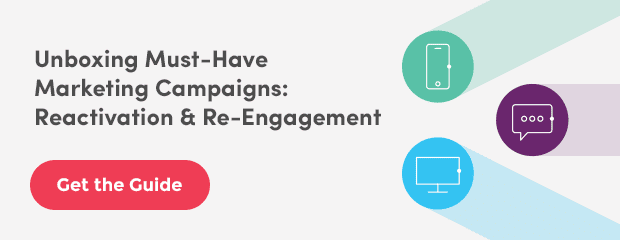In this ongoing series, we’ll be “unboxing” must-have digital marketing campaigns and programs vital to success. In this installment, we’ll take a look at reactivation and re-engagement.
It’s a well-known fact at Iterable: Email list pruning isn’t always the best strategy.
To refresh your memory, it:
- May not help with deliverability issues.
- May not serve your brand’s goals, despite being a “best practice.”
- May hurt your brand’s email list profitability in the long run, in an attempt to “save money.”
That’s why for this edition of Unboxing Must-Have Marketing Campaigns, we’re going to focus on what you should do instead of pruning your list: send a reactivation or re-engagement campaign.
Download the complete guide to gain access to even more advanced tactics to up your cross-channel messaging game.
The Purpose of Reactivation and Re-Engagement
The type of reactivation campaign your brand creates is dependent on the kind of products and services sold. According to Really Good Emails, the best reactivation and re-engagement campaigns should:
- Remind the recipient of why they signed up
- Spark curiosity
- Introduce new concepts
So for B2C or e-commerce brands, this could mean an email showcasing a limited time offer. These types of emails are great for reminding inactive subscribers on your list that your brand exists and may persuade them to make another purchase with your brand.
But if your brand is a subscription business with a trial period built-in, reactivation emails can become so much more than limited-time special offers.
In fact, we can break them down into three categories of users:
- Free-to-trial
- Trial-to-paid
- Win-back cancellations
Let’s go over them, one by one.
3 Essential Types of Reactivation Campaigns for Subscription Services
1. Free-to-trial
At Iterable, we define free-to-trial as the point in time where a consumer decides to offer up some information about themselves in exchange for a free limited-time offer.
For instance, Thrive Market asks new users about what family members they’re shopping for, whether they have special diets or allergies and what’s on their typical shopping list.


Thrive Market onboards new users by asking if they have any food allergies or follow any special diets.
However, the quiz is long—we counted at least 16 questions.
So for users who don’t finish filling out the form, Thrive Market sends a series of eight reactivation emails, reminding users to pick their membership plan and why it’s in the user’s benefit to signing up.
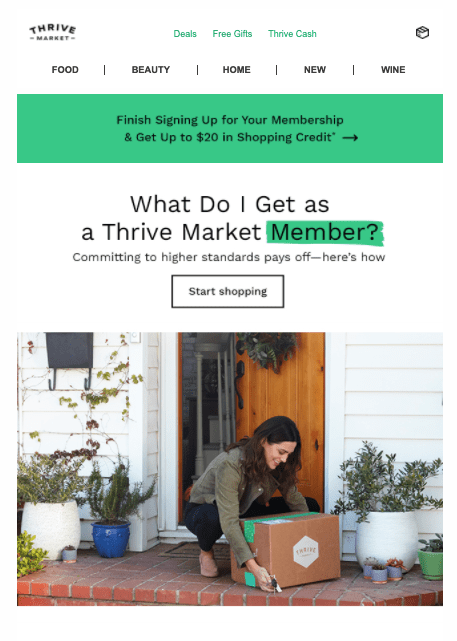



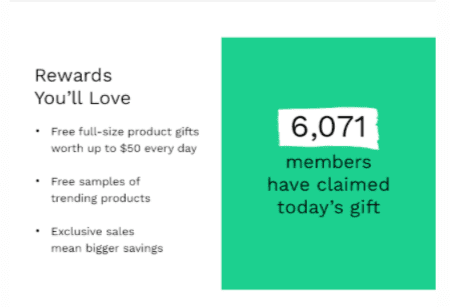

Thrive Market sends a reactivation email sent to users who put in their email for a free trial but didn’t finish their quiz.
Thrive Market knows this segment is open to buying, but not necessarily ready to do so, which is why they get straight to the point by answering the question: “What do I get as a Thrive Market member?”
Another example comes from personalized vitamin subscription Care/of, who sends new product announcements to subscribers who finished a quiz but have yet to make an order for daily vitamin packs.




Vitamin subscription service Care/of sends a reactivation email to users who have completed a quiz but haven’t made an order.
Care/of could send more reactivation emails trying to get leads to order their personalized vitamin pack. But in this particular email, they focus on cross-selling another product offering—in this case, protein powder—to see if they can get more information and possibly score an order.
2. Trial-to-paid
Once a user commits to a trial period for a product or service (usually by inputting their credit card number), the real sales process begins.
These trials can range from 7-90 days, meaning brands have only so much time to convince the user that their service is worth it.
Except?
People sign up for things and then get busy.
Therefore, it’s your job as a marketer to remind trial customers of how their lives will change if they continue using your brand’s subscription service.
How do you do that? With a reactivation campaign, of course.
This article outlines numerous examples of how to write a trial ending or expired email, but here are a few more examples.
First, let’s view this humorous reactivation email from popular budgeting software You Need a Budget (YNAB).
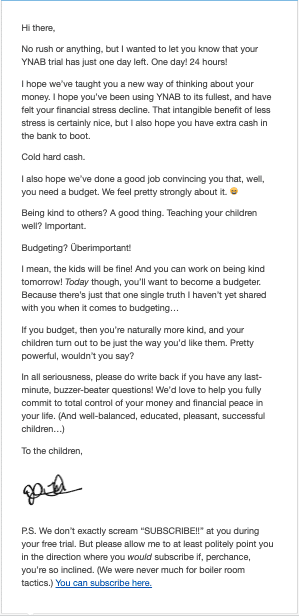

Personal finance tool You Need a Budget (YNAB) alerts users they only have one day left in their trial period.
YNAB pokes fun at the fact that most trial renewal emails can sound a little desperate. Instead of the usual trial-ending email, they write a narrative letter to the user about how budgeting should leave you with more cash, a kinder spirit and a legacy to leave behind to your children (with a soft call-to-action located in the postscript).
But sometimes, trial users aren’t ready to commit (especially if they didn’t have time to do everything they wanted to do).
In the following email from website builder Squarespace, they reiterate the following benefits of upgrading to a paid subscription: great design, a long list of testimonials and award-winning support.


Website builder Squarespace sends a reactivation email to trial users, reiterating the benefits of their subscription service.
Plus? Squarespace gives on-the-fence users an easy way to extend their trial by another seven days—perfect for anyone who needs a little more time to decide.
3. Win-back cancellations
Cancellations are a part of any thriving subscription brand, but that doesn’t mean the customer will never return.
Like we reiterated above, it could be that the customer:
- No longer has a budget for the product or service
- Doesn’t have a need anymore
- Has lost trust in your brand for whatever reason
- Forgot to update a credit card number, renew, etc.
Luckily, those customers can be won back with a thoughtfully crafted reactivation campaign.
For instance, food media company America’s Test Kitchen utilized an upcoming Thanksgiving holiday to win back previously paying customers.


America’s Test Kitchen sends a Thanksgiving-themed reactivation email to past customers.
Thanksgiving is the equivalent to the cooking Olympics for home chefs, so having recipes that are tested by culinary professionals is always a good idea. America’s Test Kitchen knows their customer base—and uses it to their advantage to win back past customers.
But it doesn’t even have to be paid subscribers. Take, for instance, this reactivation email sent from feedback software tool SurveyMonkey to inactive users.
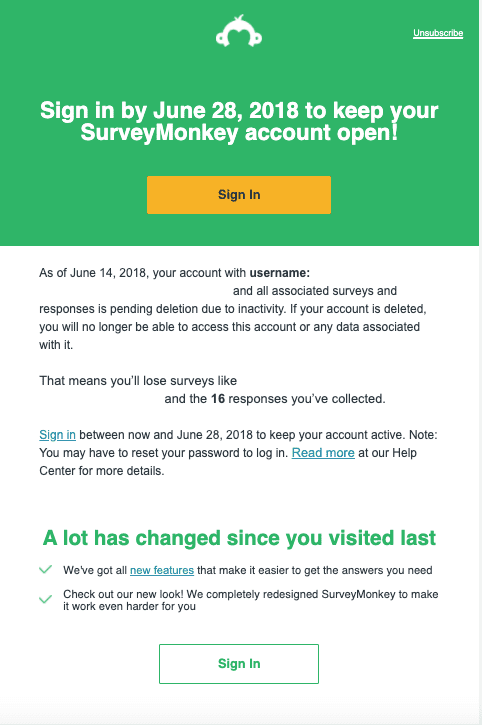

SurveyMonkey encourages inactive users to sign in with a reactivation email.
SurveyMonkey uses this email to mention its new features and design to encourage inactive users to come back. However, the message is also time-sensitive—if the user doesn’t sign in soon, SurveyMonkey warns the user that their surveys will get deleted.
A Quick Recap on Reactivation & Re-Engagement Campaigns
Reactivation emails are great for brands who have a limited time offer to notify their audience and previous customers about, but subscription businesses, in particular, have three potential categories of users to target:
- Free-to-trial
- Trial-to-paid
- Win-back cancellations
Download our full guide to master these three categories and get creative with these advanced cross-channel tactics:
- Mobile push notifications
- Text messaging (SMS)
- Website pop-ups
Now that you’re an expert on building a successful reactivation campaign, what are you going to do to stand out from the crowd?






























